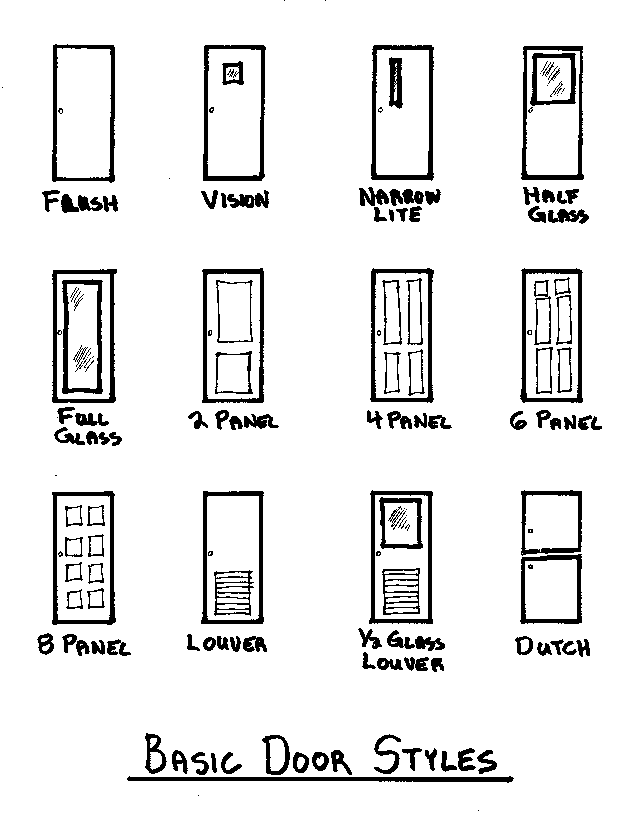 CONSTRUCTION KNOWLEDGE >>
DOORS & WINDOWS >>
CONSTRUCTION KNOWLEDGE >>
DOORS & WINDOWS >>
DOORS
1. What Types of Doors and Frames are Common?
2. What are the Basic Door Designs?
3. What Should I Know about Fire Doors?
4. What Should I Know about Overhead and Coiling Doors?
5. What Public Domain Documents are Available for Further Study?
6. Tricks of the Trade & Rules of Thumb for Doors:
What Types of Doors and Frames are Common?
Hollow Metal doors and frames get specified in many commercial and industrial buildings (probably because the steel holds up better than wood). The website for Republic Door illustrates the many options available for hollow metal products. This excellent website will give you more information about hollow metal doors and frames than you should ever need.
In recent years, I've been using hollow metal frames with pre-finished wood doors in many buildings. The hollow metal frames provides a durable way to complete the gypsum board openings and the pre-finished wood doors are attractive and economical. The Mohawk Doors seem to be common. Wood frames, using wood trim boards around a wood jamb and header, are also popular. Wood frames tend to be site built, except for pre-hung wood doors.
Aluminum and glass storefront also gets used often in commercial buildings. I've installed more Kawneer systems than any other type, but there are lots of good manufacturers. Be careful to check the shop drawings on storefront, verifying rough opening sizes and the details of the frames. Pay particular attention to the fastener location in the frame and where it will fall in your wall. Many times, particularly in cavity wall construction, fasteners fall in the cavity area and extra blocking is required or the frames need to slide in or out of the opening to catch something on which to connect. This is never a pleasant surprise if it becomes apparent only as installation begins.
What are the Basic Door Designs?
Though not inclusive, the figure shown here shows most of the common
door styles. It's worthwhile to know the names of the various styles
(most of them are obvious) because the terms are used frequently.

What Should I Know about Fire Doors?
Underwriter's Laboratories, Inc. (UL) tests and certifies fire doors. The Building Code requires UL rated fire doors to continue the fire resistance of the adjacent wall. Obviously, the goal of fire rated design assemblies is to prevent the spread of fire in a building.
You should know that fire rated doors must latch and be self-closing (either by a door closer or a release from a fire alarm signal). UL fire rated doors will have a stamp or plate that many Building Officials will verify.
A 3 hour fire rated assembly wall must have at least a Type A (3 hour) fire rated door. A 2 hour fire rated assembly wall in most cases must have a Type B (1 1/2 hour) fire rated door. A 1 hour fire rated assembly wall in most cases must have a Type C (3/4 hour) fire rated door. The fire rating on the doors must be shown on the drawings, but I include the above so you understand the basics of the system.
The allowable amount of glazing (window) in a fire rated door also gets discussed often in the field. Many Owners want to make changes in the door glazing during construction. So you should know the rules of thumb on fire door glazing. 3 hour fire doors can't have glazing, 1 1/2 hour fire doors can have a maximum of 100 square inches of glazing and 3/4 hour fire doors can have a maximum of 1,296 square inches of glazing. Again, there are code variations for certain circumstances, but these are the normal case rules of thumb.
What Should I Know about Overhead and Coiling Doors?
Overhead Doors can be used for dock doors, drive-in doors or just for large temporary openings in interior walls. The sectional overhead door is the most common type, though the rolling steel service doors also are common. The website for Overhead Doors provides good information about the various options. As in all door and window construction, you must have a well built opening for a quality door installation.
When thinking about overhead door installations, always consider the door operator. If it's an electric operator, make sure the proper coordination happens with the Electrical Contractor and the Door Supplier. This is an area that often gets worked out only at the installation stage, and then rather inefficiently. As an added value to the Project end user, you should also think how the electric operators will really get used in the life of the building. So many times the push button switches get placed in poor operational locations...or the wireless transmitter on a forklift really is the best way to open the door. So you can add value to the entire project if you think to ask these questions.
The weather stripping detail on overhead doors should always be well-considered, as it's easy to just let this happen. Even the sill detail, often a concrete detail, matters dramatically if it doesn't have enough slope away from the building and leaks in blowing rain water.
What Public Domain Documents are Available for Further Study?
The Army Carpentry Manual provides a good, practical section on
door, window and hardware installation techniques.
Tricks of the Trade & Rules of Thumb for Doors:
- Have the same person set the door frame and hang the door, when possible.
- Make sure door and window fasteners hit solid material, particularly in cavity wall construction.
- Ask how overhead door operators would ideally be controlled, rather than just locating switches wherever.
- A 3 hour fire rated assembly wall needs a Type A (3 hour) fire rated door. A 2 hour fire wall needs a Type B (1 1/2 hour) fire rated door. A 1 hour wall needs a Type C (3/4 hour) fire rated door. Be wary of Code variations.
- 3 hour fire doors can't have glazing, 1 1/2 hour fire doors can have a maximum of 100 square inches of glazing and 3/4 hour fire doors can have a maximum of 1,296 square inches of glazing. Be wary of Code variations.

